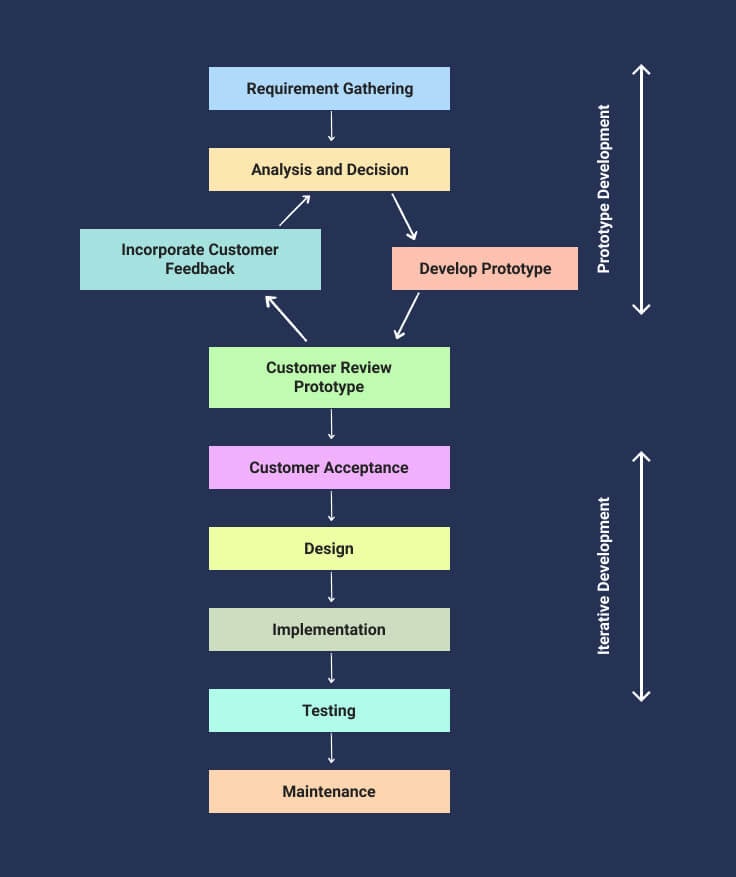In terms of software development models, software prototyping has become popular. As it helps in knowing customer requirements for the system at a very early stage. It allows software designers and developers to understand what is the expectation from the product under development.
What is a prototype model?
A prototype model is a first or preliminary version of the final software. On comparing it to actual software, a prototype becomes a basic model of the final system. A prototype has restricted functional capabilities, low reliability, and inefficient performance. The prototype model helps the best when we do not have defined project requirements..
Prototype definition:
The Prototyping Model is a Systems Development Methodology (SDM) that involves building, testing, and reworking a model output. It is one of the most popular Software Development Life Cycle Models (SDLC models).
The prototype works as a version on which various tests are conducted, and improvements are made. The process continues until a product without error is met that can be developed as a final product. The model allows users to check the developer’s concepts and test them before implementation. It serves the purpose of trial and error.
In addition to market research and user feedback, prototyping helps with market research. Along with the feedback, developers can make changes to the prototype once the client requirements are ready.
There are two dimensions for a prototype model, vertical and horizontal. A horizontal prototype shows the user interface for the product and gives a broader view of the entire system. It does not focus on internal functions. In contrast, a vertical prototype shows the internal functions. Also, the vertical prototype is a detailed representation of a specific product function or subsystem.
Each dimension serves a different purpose. Horizontal prototypes help you get information about the user interface and the system requirements. On the other hand, vertical prototypes help more technically to know the functions of the system.
Various phases of Prototyping
The Software Development Cycle of any prototype includes certain phases. Let’s have a look at them:
I. Information gathering
An analysis is done and for various details which a user requires in the system. Users are interviewed during this process to learn what they want from the system. The feedback is collected systematically and used to improve the product under development.
II. Designing
Next comes a basic design of the system after we know the requirements. It only covers the essentials, such as the software’s input and output formats. Rather than the complete plan, it focuses on the aspects that are visible to the user.
III. Developing, testing, and user feedback
After the design phase, a basic prototype is created. The prototype displays the most basic requirements and user interfaces. There are good chances that these features are not the same in the final product.
The prototype is sent for evaluation to clients. Users’ feedback plays an important role. This helps us to know the suggestions and improvements they need in the final product.
IV. Corrections
This phase is a kind of repetitive process until a final product is achieved. This phase comes to an end when a prototype is made which has all the user-specified requirements. To make the prototype better and to meet user requirements, we must keep iterating based on the feedback.
V. Final product development
Based on the improved prototype final system is made. Routine maintenance is performed on the system to minimize downtime and prevent large-scale failures.
Prototyping Models
There are several types of prototype models. A few are listed below:
I. Rapid Throwaway Model
The Rapid Throwaway Model depends on basic requirements. It is created to see how the suggestions will visually look eventually. The customer’s feedback changes the requirement, and the prototype is rebuilt until the conditions are met.
II. Evolutionary Model
Evolutionary Prototyping is also called breadboard prototyping. In this model, functionalities come into the picture. The prototype is created using limited functionalities. The developed prototype serves as the foundation for future prototypes, built on top of the entire system. Using evolutionary Prototyping Prototyping new requirements are added as and when they are received.
Prototyping based on evolutionary models is helpful in situations where new technologies are in use. Also, it is helpful for complex systems where all functionalities need to be verified.
III. Incremental Model
In Incremental Prototyping, the model developed is divided into smaller prototypes. These prototypes are further developed individually. Features are added to each prototype until the final product is achieved. Later, various prototypes are eventually combined into a single product. This method helps in reducing the amount of time it takes for the user to provide feedback to the application development team. There can be challenges in putting those sub prototypes together. Hence, we need to be careful while placing them together.
IV. Extreme Model
The method of extreme Prototyping is commonly used in web development. It is divided into three stages.
- Basic prototype all pages are present in the HTML format.
- Using a prototype services layer, you can start a data process.
- The services are incorporated and integrated into the final prototypes.
Advantages & Disadvantages of Prototyping Model
Advantages of Prototyping |
Disadvantages of Prototyping |
| Due to user involvement, the product risk to fail decreases.
As there is a basic model, users will have a better understanding of the final system. Less time and cost as the errors are known earlier, and corrections are made. User feedback helps in developing a better solution. Functionalities can be verified, and the missing ones can be added. Complex functions can be identified and made more straightforward. A prototype can be used as a resource to educate future users. It gives scope for innovations and designs. |
There is insufficient requirement analysis as a complete prototype is in use.
Confusion can be there between the prototype and the final product. This methodology may increase the system’s complexity as the scope of the system expands beyond the actual plans. Developers can use the prototype as the final product, which can lead to technical issues. The time invested in a prototype can be wasted if it is not implemented efficiently. The improvement at every stage needs to be done quickly, or the prototype cannot be moved to the next step. |
Conclusion
One can create a working “prototype” or an early sample of what’s to come using the prototyping method. Prototyping helps for developing user interfaces, high technology software, and systems with complex algorithms and interfaces. Latest trends like Minimum Viable Product (MVP), Scrum, etc., help develop software better!
COMMENT
No Comments found.
DETAILED INDUSTRY GUIDES
Software Development - Step by step guide for 2024 and
beyond | OpenXcell
Learn everything about Software Development, its types, methodologies, process outsourcing with our complete guide to software development.
Headless CMS - The complete guide for 2024 | OpenXcell
Learn everything about Headless CMS along with CMS, its types, pros & cons as well as use cases, and real-life examples in a complete guide.
Mobile App Development - Step by step guide for 2024 and beyond | OpenXcell
Building your perfect app requires planning and effort. This guide is a compilation of best mobile app development resources across the web.
DevOps - A complete roadmap for software transformation | OpenXcell
What is DevOps? A combination of cultural philosophy, practices, and tools that integrate and automate between software development and the IT operations team.
GET QUOTE
MORE WRITE-UPS
Looking for a healthcare professional? Try Teladoc. Need help tracking your daily medicine dose manually? Well, Medisafe is the answer for you. Want to take better care of your physical…
Read more...
Building a web project and confused between Nuxt vs Next, what should you choose? Here, we will give you an overview of features, pros, cons, differences, similarities, and more to help…
Read more...
Synopsis NFT marketplace has become the new buzzword, and NFT marketplace development is the in-trend service. But why? The answer is that it opens up new opportunities for many to…
Read more...






